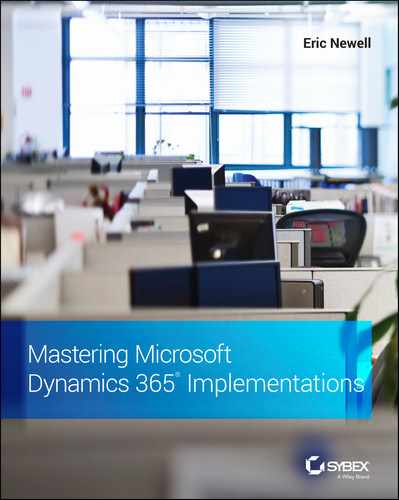Confidently shepherd your organization’s implementation of Microsoft Dynamics 365 to a successful conclusion In Mastering Microsoft Dynamics 365 Implementations, accomplished executive, project manager, and author Eric Newell delivers a holistic, step-by-step reference to implementing Microsoft’s cloud-based ERP and CRM business applications. You’ll find the detailed and concrete instructions you need to take your implementation project all the way to the finish line, on-time, and on-budget. You’ll learn: Perfect for CIOs, technology VPs, CFOs, Operations leaders, application directors, business analysts, ERP/CRM specialists, and project managers, Mastering Microsoft Dynamics 365 Implementations is an indispensable and practical reference for guiding your real-world Dynamics 365 implementation from planning to completion.
Table of Contents
- Cover
- Title Page
- Copyright
- Dedication
- Acknowledgments
- About the Author
- About the Technical Editor
- Introduction
- Chapter 1: Stages of an Implementation Overview
- Chapter 2: What to Do Before You Begin a Project
- Chapter 3: Four Keys to Consider When Buying an ERP or CRM Solution
- Chapter 4: How to Evaluate and Buy Business Application Software
- Chapter 5: Organizing Your Team for Success and Project Governance
- Chapter 6: Sprints and Tools Needed to Run Your Project
- Chapter 7: Change Management Throughout Your Project
- Chapter 8: Organizing Your Business by Processes
- Chapter 9: Independent Software Vendors—Filling Gaps and Managing Partnerships
- Chapter 10: Factors for a Successful Project Kickoff
- Chapter 11: Designing the Software Collaboratively
- Chapter 12: Requirements Gathering and Staying “In the Box”
- Chapter 13: Conference Room Pilots
- Chapter 14: Dealing with Challenges Mid-Project
- Chapter 15: Customizations vs. Configurations and How You Manage Them
- Chapter 16: Data Migration—Early and Often
- Chapter 17: Environment Management and Deployments
- Chapter 18: Testing
- Chapter 19: Training for All
- Chapter 20: Going Live
- Chapter 21: Hypercare
- Chapter 22: Support and Enhance Your Project
- Chapter 23: Bringing It All Together
- Appendix: The Bottom Line
- Chapter 1: Stages of an Implementation Overview
- Chapter 2: What to Do Before You Begin a Project
- Chapter 3: Four Keys to Consider When Buying an ERP or CRM Solution
- Chapter 4: How to Evaluate and Buy Business Application Software
- Chapter 5: Organizing Your Team for Success and Project Governance
- Chapter 6: Sprints and Tools Needed to Run Your Project
- Chapter 7: Change Management Throughout Your Project
- Chapter 8: Organizing Your Business by Processes
- Chapter 9: Independent Software Vendors—Filling Gaps and Managing Partnerships
- Chapter 10: Factors for a Successful Project Kickoff
- Chapter 11: Designing the Software Collaboratively
- Chapter 12: Requirements Gathering and Staying “In the Box”
- Chapter 13: Conference Room Pilots
- Chapter 14: Dealing with Challenges Mid-Project
- Chapter 15: Customizations vs. Configurations and How You Manage Them
- Chapter 16: Data Migration—Early and Often
- Chapter 17: Environment Management and Deployments
- Chapter 18: Testing
- Chapter 19: Training for All
- Chapter 20: Going Live
- Chapter 21: Hypercare
- Chapter 22: Support and Enhance Your Project
- Chapter 23: Bringing It All Together
- Glossary
- Index
- End User License Agreement
